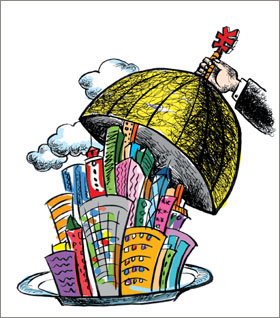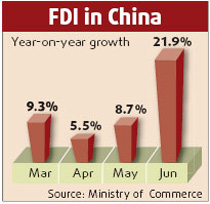In Shenzhen, the decline in volume of new residences, combined with sharp decreases of house purchases for investment and consequent property auction failures, have proved that the “turning point” inside the real estate market in Shenzhen, a special economic zone in south China’s Guangdong Province, has already come, much earlier than market expectations.
Great ups and downs
“The property market in 2007 can be described as “rare”, it was extremely hot during the first half of last year, then it experienced depression during the second half,” said Liang Wenhua, General Manger of Shenzhen-based Shihua Real Estate, during an interview with the China Business News.
In the spring of last year, hosing prices in Shenzhen rose sharply. The monthly average price increase for newly built commercial houses reached 13.5 percent in the first ten months, making it the fastest among China’s 70 large and medium-sized cities, according to statistics from the National Development and Reform Commission (NDRC).
The average price of residential buildings was 10,872 yuan (US$ 1,495) per square meter in January 2007 but the same year saw a record high of 16,777 yuan (US$ 2,307), a rise of almost 60 percent. The second-hand house market enjoyed more of a boom, with prices increasing from 8,984 yuan (US$ 1,235) in December 2006 to 14,572 yuan (US$2,004) in June 2007, up 62 percent in six months. Prices of some high-class apartments even posted more than a 90 percent rise in this city.
The housing market in Shenzhen experienced a sharp decline in October last year, with property sales of only 82 units during the seven-day National Day holidays. The floor space of commercial housing dropped by 37.5 percent in 2007 as compared to the same period in 2006, with residential building down 40.5 percent and sales of commercial houses decreasing by 13.2 percent, based on an analysis from the Shenzhen Statistics Bureau.
Significantly, this “turning point” arrived earlier than market forecasts had predicted. More and more people were taking a wait-and-see attitude towards buying houses in the latter half of 2007. Sales in October, November and December hit a record low of the year, while the 2006 market was the most prosperous during those very same months.
Prices for new residential buildings hit a record high in September of last year and then it began to fall. They experienced a continuous decrease in the following months of the year.
The price of second-hand houses stopped rising as of last August. Only 1,139,900 square meters were sold in the third quarter of 2007, down more than 60 percent from the second quarter, based on the statistics from the Zhongyuan Property Agent.
The sharp fall took place during the fourth quarter and was due to low sales volume. The volume of second hand residential buildings hit 661,800 square meters, with the price falling by 10 percent as compared with the same period in 2006.
The average price of second hand properties hit 12,729 yuan (US$1,750) in 2007, or a year-on-year increase of 51 percent, still a large number due to the sharp rise in the first six months.
“There were really great ups and downs in the market, that’s very rare,” commented Liang Wenhua.
The land is unbeaten?
Rising property prices are attributed to a limited land supply; this is commonly understood among real estate industry insiders in Shenzhen. “In the long term, land supplies in Shenzhen will be very limited,” said Feng Yongheng, a research fellow with Midland Realty (Holdings) Limited. He believed that land cost is the key factor toward deciding housing prices in Shenzhen. Land prices will rise as the land supply for housing decreases, and then the house prices will continue to go up.
In 2006, the Shenzhen municipal government leased land consisting of 906,000 square meters for commercial and residential buildings. But in 2007 the government has leased only 409,000 square meters, according to the latest statistics.
The government has tightened up land supplies and held land sales via public auction, causing a shortage in land supplies. Property prices rose. According to an official document issued in 2006, the land supply for residential houses construction would decrease year by year after 2007.
Unexpectedly, many managers of house agencies did not agree with such a statement. “Many land auctions have failed recently and one reason for this is due to government controlled housing policies that keep purchasing costs artificially low. At the same time real estate developers still need to turn a profit on the market,” said Liang, holding the view that the overheated property market had led to increasing land prices.
“Demand dictates price,” said Zou Jianmin, a real estate investor. He did not agree that land supply was a key factor in deciding housing prices.
In Shenzhen, six land auctions failed last December and an unsuccessful auction also took place in 2006.
“Developers have their bottom lines; building houses does not always make money,” said Wang Shuquan, General Manger of the Midland Realty (Holdings) Limited. He stressed economic laws, and he maintained that housing prices would decline.
Credit squeeze
However, most insiders think that the decisive factor behind the cooling real estate market in Shenzhen revolves around dwindling investments.
Statistics from the Shihua Real Estate indicate that several policies aimed at cooling down the property market went into effect, the ratio of deals for investment purposes lowered to 10 percent of all the trade volume in the property market, as compared to a maximum of 80 percent during the first half of 2007.
The launch by several banks of lucrative loans definitely influenced investor’s zeal. According to the long-term observation of house-mortgaging business conducted by the Shihua market research center, about 70 percent of house loan borrowers paid a down payment of less than 20 percent. As a result, last year many banks reached their annual line of credit by the third quarter.
Last year the Shenzhen Branch of the China Construction Bank called a halt on August 22 to dispersing credit toward real estate purchases. They were the first among all the commercial banks to do this. Other banks announced a suspension of their “mortgage transfer” business, thus not allowing other mortgage holding creditors to transfer their loan credits they obtained in one bank into another bank in order to get a second mortgage.
Those measures cut off the sources of funds for investment-oriented house buyers and finally led to decline of property market.
On the other hand, policies released by the People’s Bank of China and the China Banking Regulatory Commission last year did go into effect. The policies raised the down payment threshold and rate of housing mortgage for the people buying their second home, immediately curbing investment and speculation in the red-hot property market.
Statistics from the Shenzhen Municipal Bureau of Land Resources and Housing Management indicate that the trade volume of the real estate market in the city dropped to a nadir of 355,500 square meters in October last year, down by 36.78 percent from September.
This sudden market shrinkage hit real estate agents severely; several agencies even closed down.
About 41 percent prospective house buyers could not afford to make down payments, according to a survey by the Shihua. Meanwhile, developers became cautious in land purchases.
The distorted market
Affected by the long-term investment spree, the structure of the real estate market in Shenzhen became distorted because apartments with large areas – over 90 square meters - were warmly welcomed by most investors.
Statistics from the Zhongyuan Property Agent show that 55 percent of all the 59,453 apartments available in the 2007 Shenzhen market have dimensions of less than 90 square meters. This is lower than the government goal of a 70 percent ratio.
House hunters’ intentions are also abnormal. Statistics from Shihua indicate that 60 percent of the home buyers bought houses for investment purposes during the first half of 2007, and statistics from Zhongyuan show that the figure went up to 80 percent in May and June against those buying homes as personal dwellings.
“Such market structures are not a good omen. It indicates that the market base is unsteady since the most active people on the market are investors,” said Wang Shuquan. He added that a mature consumer layout should be 60 percent occupied by first-time property purchasers, 30 percent by investors, and 10 percent by luxury house owners.
No reason not to lower the price
Considering the unprecedented low trade volume, Wang Shuquan said, “There’s no reason why we won’t see house prices go down.” Sharing Wang’s opinion, Lin Xiaohua, Assistant to General Manager of Shenzhen JoinSun Real Estate Agent, estimated that cheaper apartments flooding the market soon would also lower the housing price index.
As they expected, Shenzhen branches of Vanke Property and China Oversea Property have in the first batch adopted a price-lowering strategy.
“It’s a clever decision,” Liang Wenhua praised the step made by the two developers. He added, “Lowering prices will not only withdraw currency so as to seize critical marketing opportunities but also gain great social merit.”
“Each side, developers and consumers, should become rational again, then both sides can benefit from a balanced market. A wild market is harmful for everyone,” warned Wang Shuquan.
(China.org.cn by Yang Xi and Zhang Tingting, January 17, 2008)



